Country Profile: The Guide to Ecommerce in the United States
In the world of ecommerce, one market looms larger than the rest: The United States of America. The U.S. has long enticed businesses as the land of opportunity.
Third in the world in population, America’s 300 million-plus people are among the wealthiest on the planet, and they’re primed to spend online. America is the nation where ecommerce first took root, and ecommerce continues to grow there, expanding into every conceivable corner of the economy.
Are you ready to make it in America?
In this comprehensive guide, we’ll survey the U.S. market for ecommerce, highlighting trends relevant to foreign companies looking to enter the market (many of these trends will also be of interest to existing U.S. brick-and-mortar stores who are expanding into ecommerce). Then we’ll profile the buying habits of the typical U.S. consumer and illuminate some of the key benefits and opportunities of selling into the U.S.
We’ll also explore some of the challenges involved with ecommerce in the United States, including the risk of online payment fraud. Finally, we’ll offer some tips for preventing fraud when selling into the U.S. market.
Grab your stars and stripes, and let’s get started.
U.S. Market Overview
On Aug. 12, 1994, the New York Times reported that a day prior, a man in Philadelphia had logged onto his computer and used his credit card to purchase a Sting CD online from a company in New Hampshire. It was – according to the Times, anyway – the first-ever secure retail transaction on the internet, made possible by recently-released advanced encryption software.
It was the dawn of a new era in the United States. By the closing of the 20th century, ecommerce had become, if not commonplace, accepted as a safe way to shop. Big names like Amazon (founded in 1994) and eBay (1995) led the way.
Nowadays, shopping online is second nature to most Americans. Between the first quarter of 2000 and the third quarter of 2019, ecommerce sales as a percentage of total retail sales leaped from 0.8% to 10.5%. Excluding categories such as groceries, gasoline, and automobiles, ecommerce accounts for nearly 20% of consumer spending in America.
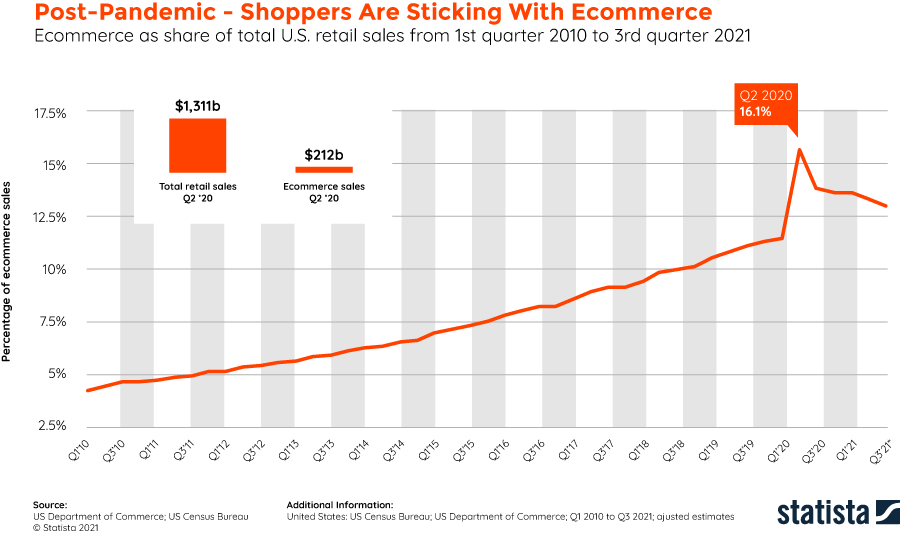 You will find more infographics at Statista
You will find more infographics at Statista
According to the latest information published by Statista, U.S. retail ecommerce sales totaled $365.2 billion in 2019. By 2024, the total will reach nearly $600 billion.
The U.S. market is a global leader in ecommerce. Digital marketing research firm eMarketer ranks the U.S. second worldwide in retail ecommerce sales, behind China. America’s northern neighbor, Canada, ranks eighth. (According to Statista, retail ecommerce revenue in Canada reached $25.4 billion in 2019.)
Another global ranking of ecommerce markets, by ecommerce platform eShopWorld, accounts for factors such as logistics, average revenue per shopper, and percentage of the population shopping online. The U.S. claims the number-one spot on this list, “largely due to the ease of doing business in America.” China comes in second, and Canada takes the seventh spot.
A Market Dominated by a Single Company
The elephant in America’s ecommerce market is Amazon. As of February 2020, sales on Amazon accounted for 38.7% of all U.S. retail ecommerce sales. The next closest competitor, Walmart, accounts for 5.3%. Other well-known brands, such as Best Buy, Target, and Macy’s, hold less than 2% of the market each.
Here are some other staggering facts about Amazon (all compiled by nChannel):
- Amazon averages more than 200 million unique visitors per month.
- There are more than 100 million Amazon Prime subscribers in the U.S.
- Prime members spend an average of $1,400 per year with Amazon, nearly double the amount non-members spend.
- Nearly half of all Amazon sellers generate over 80% of their revenue from Amazon sales.
- Almost half of U.S. internet users start product searches on Amazon (compared to 35% on Google).
Ecommerce Shopping Habits and Demographics in the United States
The Age of Online Shoppers in America
As is true in many other markets, the most frequent ecommerce consumers in the U.S. are also among the youngest. According to Statista, about 20% of online shoppers in the U.S. are between the ages of 25 and 34. Shoppers between 35 and 44 account for another 17% of the market.
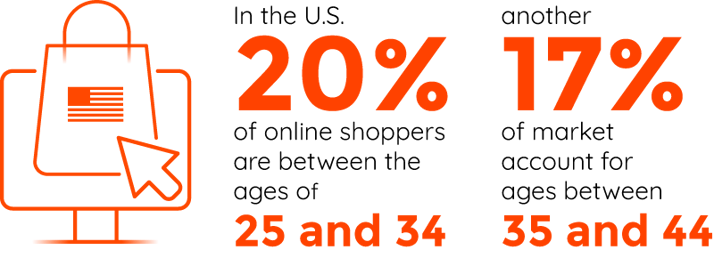
Older Americans do shop online, however. Americans between 45 and 54 account for 15.5% of the market, and those between 55 and 64 and those over 65 account for 14.6% and 14.4%, respectively.
Most Americans under 55 (45%) spend between $64 and $259 per month on online shopping; 27% spend over $260 per month (according to a 2020 ClearSale survey of over 1,000 American consumers). Conversely, only 10% of Canadians in this age group spend over $260 per month.
American Millennial Shopping Habits
One survey from 2019 found that millennials in the U.S. (between the ages of 22 and 37 at the time of the survey) make 60% of their purchases online. Among those surveyed, 64% said they make half or more of their online purchases from Amazon. The survey respondents cited the availability of online reviews and low prices as their top reasons for choosing Amazon over other merchants.
Frequency of Online Shopping
More than half of American ecommerce consumers make purchases online several times per month; 20% say they shop online every week. An additional 15% say they make online purchases once per month.
Most Popular Categories for Online Shopping
As of February 2020, ecommerce sales accounted for 54% of all book, music, and video sales, and 42% of all computer and consumer electronic sales in the U.S. The next two most popular categories for online shopping were toys and hobbies (about 37% of all sales) and apparel and accessories (about 29%).
There are some categories, however, in which ecommerce has barely made an impact. Only 3.2% of food and beverage sales in the U.S. were online in 2020, as were less than 4% of automotive and auto parts sales.
Sorted by gender, the most popular online shopping category for American women is fashion, clothing, and accessories. A November 2017 survey found that 71% of American women had purchased clothing online in the past three months. Technology (including phones and computers) is the only product category American men buy more online than women.
Of course, since these initial stats were compiled, the lifestyle of many Americans has changed, with the COVID-19 pandemic working its way into the U.S. While the existing popular ecommerce categories are still strong, certain specific products have seen a major increase in demand. Our friends at Shopify revealed the top trending product categories in the U.S. for the week of April 27:
- Novelty signs (856%)
- Beach towels (212%)
- Toners & astringents (114%)
- Vests (112%)
- Kitchen towels (102%)
- Tumblrs (100%)
- Necklaces (88%)
- Dog toys (80%)
- Bracelets (62%)
- Kitchen knives (66%)
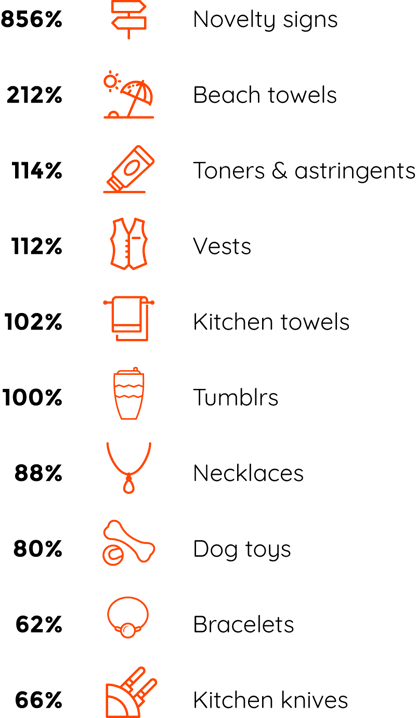
Key Benefits and Opportunities of Selling in (or into) the U.S.
The most obvious reason to do business in America is that the United States is the world’s largest economy, a position the country has held since 1871. In fact, the U.S. represents nearly a quarter of the global economy, thanks in part to its abundant natural resources, advanced technology and infrastructure, and large population.
Investopedia assesses the U.S. economy at $20.58 trillion in 2018. It is expected to reach $22.32 trillion by the end of 2020.
But there are other good reasons to expand your ecommerce business into the United States:
High Internet Penetration and Technology Adoption
As of 2019, 90% of U.S. adults were internet users. This percentage has been climbing steadily from 2000 when it represented only about half of the U.S. population.
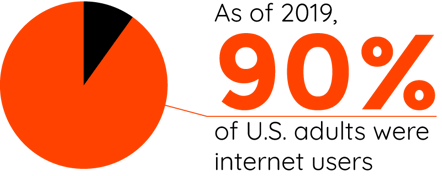
According to the Pew Research Center, internet penetration is even higher for younger age groups. Among Americans ages 30 to 49, internet penetration was 97% in 2019. All Americans (100%) between the ages of 18 and 29 that Pew surveyed said they were internet users.
As for the frequency of internet use, about eight out of every 10 Americans say they go online at least once a day. 28% of Americans say they’re online “almost constantly.”
While the vast majority of Americans are internet users, Americans do not all access the internet the same way. By Pew’s count, as of 2019, 73% of U.S. adults were home broadband users. 17% of American adults said they do not use broadband at home but own smartphones. (This percentage is somewhat higher – 22% -- for the 18 to 29 age group.)
Americans, in general, are enthusiastic adopters of mobile technology. In 2019, 96% of Americans owned a cellphone of any kind, and 81% owned a smartphone. A little over half of American consumers reported owning a tablet device.
Almost all American millennials (93%) own a smartphone, and most Gen Xers (90%) do, as well. 68% of the Baby Boomer generation (born between 1946 and 1964) report owning a smartphone.
Willingness to Shop Across Borders
While America is known for its domestic ecommerce behemoths (especially Amazon), Americans are not averse to shopping beyond the borders of their own country to secure a deal or access products they can’t get at home.
According to Statista, 27% of American online shoppers said they bought from domestic and cross-border sites in 2018. About two-thirds of respondents said they purchased from domestic sites only. 7% said they purchased from cross-border sites only.
What do Americans like to purchase abroad? Top categories include automotive; vehicle parts and accessories; clothing, shoes, and accessories; home and garden products; sporting goods; and jewelry and watches.
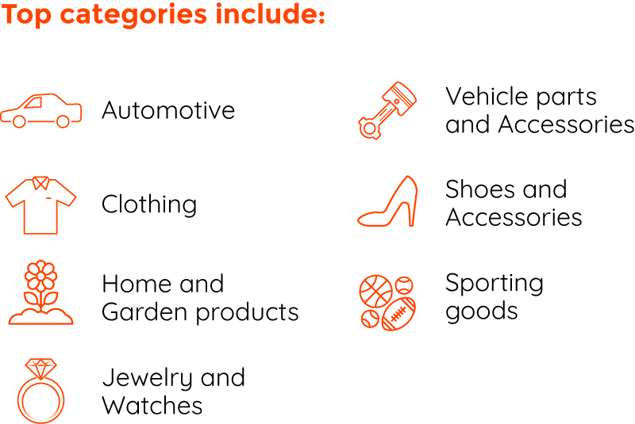
The Challenges of Ecommerce in America
Competition
As one would expect, the world’s largest economy and second-largest market for ecommerce attracts the biggest players. The competition is fierce for ecommerce customers in the U.S., and new entrants into the market must go up against giants like Amazon, who, because of their sheer scale, can offer perks like free two- or one-day shipping, convenient returns, and low prices.
On the other hand, rather than launching their own sites, ecommerce merchants can choose to do business on existing marketplaces like Amazon or eBay. The pros of selling on Amazon include access to hundreds of millions of potential customers, a readymade storefront that allows customers to review your products, minimal costs for web hosting, and less worry about logistics and shipping.
The downside of selling on Amazon is the competition and lack of control. As an Amazon merchant, you will not be able to tailor the shopping experience to your customers' needs and your brand image.
Tax Complications
In the federal system of the United States, each state determines its own system of sales tax. Some states have no sales tax at all. In the 45 states that do charge sales tax, rules, rates, and regulations vary.
For example, some states waive sales tax for groceries, while others do not. Some states tax shipping charges, while others do not.
This can be confusing to merchants that are accustomed to working in more centralized systems. We recommend you consult with an expert on U.S. taxes before entering the American market.
Difficult Logistics
The United States is not only one of the largest countries in the world by population. By landmass, the U.S. is fourth largest in the world.
Much of the country is populated, although quite sparsely in some areas. This can present some logistical challenges, especially to companies that aren’t familiar with American geography. (Ecommerce merchants in Canada face a similar situation.)
Ecommerce Fraud in the United States
Payment fraud is a global phenomenon. Card-not-present (CNP) fraud is especially on the rise, even as in-person fraud declines due to widespread adoption of payment card chip technology. Card-not-present fraud is expected to result in global losses of $130 billion between 2018 and 2023.
Naturally, the United States, with its wealthy residents and robust ecommerce economy, has become a prime target for online fraudsters. U.S. merchants lost $6.4 billion to fraud in 2018, and some experts projected cumulative losses of over $70 billion over the next five years.
Some reasons for rising CNP fraud rates in the U.S. include:
- Delayed rollout of fraud-prevention measures, such as 3D Secure 2.0. (The first iteration of 3D secure never gained a significant foothold in the U.S.)
- An increase in in-store returns. Fraudsters have learned to make fraudulent purchases online and then return the merchandise to brick-and-mortar stores for a refund.
- A new form of fraud called “click-and-collect.” “Click-and-collect” takes advantage of in-store pickup, an increasingly common option offered by ecommerce retailers. With in-store pickup, customers are not required to provide a shipping address, making it more difficult for merchants to validate transactions at the point of sale.
For every dollar of fraud committed, U.S. retailers lose an average of $3.13.
The frequency of data breaches is also skyrocketing in the U.S. Each new incident exposes payment card information for thousands or millions of consumers to the risk of fraud.
Data breaches rose 17% in 2019, including high-profile victims such as Capital One, Wawa, and DoorDash. Fraudsters build off the information they gain in data breaches to instigate account takeover attacks, compromising other customer accounts.
Industries and Regional Markets with the Highest Level of Fraud Risk
Fraudsters prefer to target products they can resell easily. So, the product categories that are the highest risk for fraud in the U.S. tend to be high value, high demand, and small enough to ship easily and cheaply.
ClearSale internal data allows us to classify product categories into risk groups, which are broken down in the chart below:
|
Category |
Risk Group |
|
Digital goods |
High |
|
Alcohol & pharmaceutical drugs |
High |
|
Games |
High |
|
Home Appliances |
High |
|
Jewelry |
High |
|
Phones and Electronics |
High |
|
Watches & Glasses/Eyewear |
High |
|
Hardware/Home Improvement |
Medium |
|
Fashion Luxury |
Medium |
|
Apparel - Ticket Above $200 |
Medium |
|
Automotive Parts/Accessories |
Medium |
|
Housewares/Home Furnishings |
Medium |
|
Mass Merchant selling in multiple categories |
Medium |
|
Musical Instruments |
Medium |
|
Shoes |
Medium |
|
Sporting Goods |
Medium |
|
Tactical Gear |
Medium |
|
Toys & Hobbies |
Medium |
|
Travel & Tourism |
Medium |
|
Apparel - Ticket Below $200 |
Low |
|
Books/Music/Video |
Low |
|
Children & Baby Products |
Low |
|
Flowers/Gifts |
Low |
|
Health/Beauty |
Low |
|
Pet Shops |
Low |
ClearSale internal data indicates that the U.S. states with the highest risk of fraud are Florida, New York, and Michigan. Within Florida, most of the fraud is concentrated around Miami, due to the high presence of freight forwarders. In New York, the borough of Brooklyn has the highest fraud rate.
Government Response to Fraud
Despite the high and growing rate of CNP fraud in the United States, the U.S. government has not made combatting fraud a priority. There are currently no U.S. equivalents to the European Union’s Payment Services Directive 2 (PSD2), a regulation that, among other things, requires an additional layer of fraud protection on electronic purchases known as Strong Customer Authentication (SCA).
However, ecommerce merchants should be aware of the California Consumer Protection Act (CCPA). Going into effect on Jan. 1, 2020, CCPA grants California residents certain rights concerning the personal information they share with for-profit organizations online (get more specifics here).
The California Consumer Protection Act applies to any merchant that meets certain criteria for doing business in California. Consult with an expert to determine whether your business must comply with CCPA.
And keep in mind: California is America’s most populous state. You likely do not want to miss out on the millions of potential customers there.
How to Prevent Fraud When Selling into the U.S.
Payment fraud is a significant risk to ecommerce merchants (in the U.S. and everywhere else) for several reasons. There is, of course, the cost of losing merchandise and never getting it back. But there is also the cost of chargebacks to consider.
Chargebacks occur when consumers notice an unauthorized payment on their credit or debit account and ask their bank to reverse the charge. If the issuer determines the claim is legitimate, they will refund the payment and debit the merchant – usually with an additional fee.
Chargeback fees can range from $50 to $100 or more per transaction. The more chargebacks a merchant incurs, the higher their fees will be. In some cases, banks will remove a merchant’s ability to accept credit card payments entirely.
Another indirect cost of CNP fraud is the damage it can do to a merchant’s reputation. American consumers tend to distrust merchants they feel will not handle their personal information securely.
In our survey of 1,000-plus U.S. online shoppers (which we mentioned above), 51% of respondents said they had abandoned a purchase because they didn’t trust the site with their credit card information.
4 Options for Fraud Protection
1. Fraud Filters
Typically, the first line of fraud defense for ecommerce merchants doing business in the U.S. market is the fraud filter. Fraud filters are provided by ecommerce platforms and are designed to identify potentially fraudulent orders and stop them from being processed.
Fraud filters can function a number of ways, such as by:
- Limiting how many sales can be submitted to a website during a given time period.
- Using an address verification service (AVS) to ensure shipping and billing addresses line up.
- Flagging or blocking transactions that occur during specified timeframes.
- Checking for errors with the card verification value (CVV) submitted.
- Flagging high-dollar sales that fall outside the merchant’s typical range.
- Looking for IP address mismatches.
While these common filters can prevent a high amount of fraud, they may also stop even more legitimate transactions.
The Risk of False DeclinesWhen legitimate transactions are caught up in efforts to prevent fraud, they are called false declines. False declines are a risk anywhere merchants use automated fraud rules. In high-risk industries, merchants may tighten up their fraud rules, only to lose even more revenue to false declines. According to the ClearSale survey:
When the cost of lost revenue, dissatisfied customers, a worsened reputation, and poor online reviews are taken into account, false declines can cost businesses much more than actual fraud (perhaps up to 13 times as much). U.S. merchants lose nearly $118 billion each year to falsely declined transactions. |
2. Manual Review
An alternative to automatic fraud filters is manual review, which is just what it sounds like: a team of individuals reviewing each transaction (or a selection of transactions) to detect fraud.
Human fraud experts tend to be better than machines at understanding context. Trained fraud experts can look at each situation individually instead of blindly adhering to preset rules.
However, manual review is very time-consuming and resource-intensive. A drawn-out manual review process can annoy customers who are eager to complete their orders.
3. Machine Learning/Artificial Intelligence
Software that relies on machine learning or artificial intelligence (AI) can provide a fast and reliable way to screen out fraud. These applications rely on mathematical algorithms and data to identify fraud trends and patterns. Because no humans are involved, machine learning is scalable and consistent, applying the same level of scrutiny to every transaction.
Unfortunately, like “unintelligent” fraud filters, machine learning can be inflexible. Algorithms can also miss new types of fraud that haven’t yet made it into the algorithm’s database.
4. Fraud Managed Services
Fraud managed services is a “best of all worlds” approach that combines cutting-edge automated technology (including advanced fraud filters and machine learning) with expert manual analysis.
At no point is an order automatically declined. Instead, when the automated system flags an order, the order is passed on to the team of experts who use their knowledge of human behavior and the latest fraud trends to make a final call. The human analysts can flag new trends for insertion into the AI’s algorithm, thereby helping the machine learn faster.
The goal with this approach is to reduce or eliminate false declines entirely while providing a quick, seamless shopping experience to customers – all while staying one step ahead of the most sophisticated fraudsters.
The Effective Fraud Solution for Ecommerce in the U.S.: ClearSale
At ClearSale, our fraud managed services solution combines advanced statistical and artificial intelligence technology with the world’s largest team of specialized fraud analysts to deliver a balanced, real-world approach that is unlike anything else in the American ecommerce market.
With ClearSale, ecommerce merchants receive:
- Simple ecommerce integration. Our fraud protection solutions quickly integrate with all major ecommerce platforms via an easy-to-install plugin.
- Near-immediate order approvals. Even our human analysts are fast.
- Comprehensive protection against fraud. ClearSale’s Chargeback Insurance program offers 100% guaranteed coverage of all fraud-related chargebacks.
- The highest approval rates in the U.S. (and anywhere else). Our system will never auto-decline an order.
- An innovative approach. Our multitiered team approach to fraud prevention lets us continually calibrate our proprietary statistical model as new fraud patterns emerge.
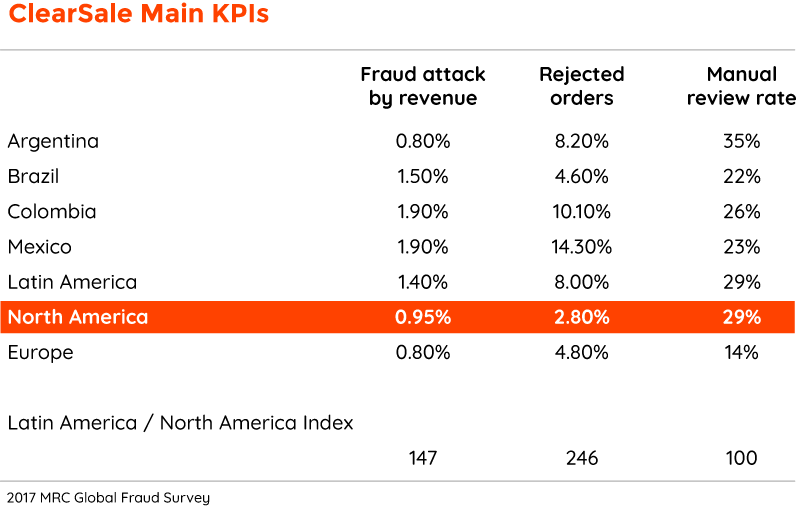
With our headquarters nearby in Latin America, ClearSale knows the American market. If you’re thinking about expanding the reach of your ecommerce business into the United States of America, get in touch with us today to talk about keeping your business, your reputation, and your customers safe from fraud.
 Rafael Lourenco
Rafael Lourenco
